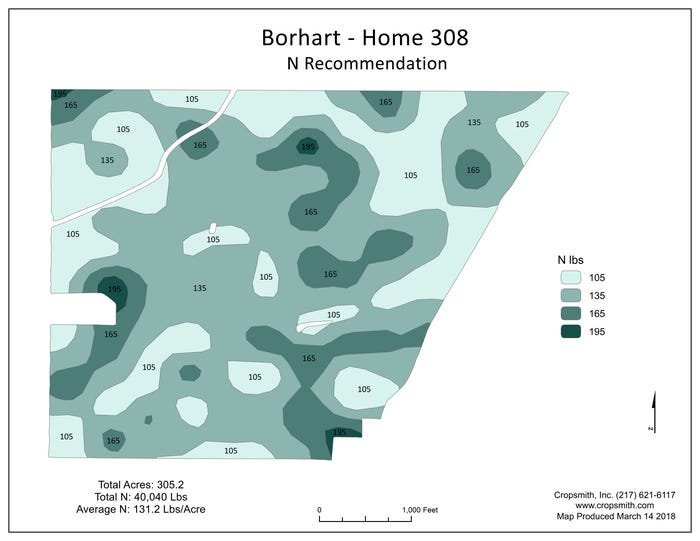April 23, 2018

-----------
Think Different
Consider getting a second opinion from an independent source when evaluating your nitrogen recommendations.
Find a consultant trained in ISNT, ADAPT-N or other nitrogen evaluation-based systems and compare recommendations with your current source.
Ask about local plot-based calibrations to apply these tests to your acres.
Test the alternative system, analyze the results and adopt accordingly.
------------
When Larry Borhart saw the cost of his longtime dealer's fertilizer recommendation skyrocket 10 years ago, he brought in a second opinion. When the new recommendation reduced his per-acre N purchase from 200 to 140 lbs./acre, Cropsmith consultant Tim Smith had Borhart's attention.
"He got me interested in the Illinois Soil Nitrogen Test (ISNT) and variable rate sidedressing," recalls Borhart. "It took about six months, and he had me talked into buying sidedress equipment."
In the decade since, Borhart and his wife Misty have followed Smith's recommendation on their 1,500 acres, split between corn and soybeans in central Illinois. They apply a flat rate of 50 lbs. pre-plant, then sidedress a variable-rate average of 90 lbs. applied early season. Most years their corn averages 220 bushels per acre, jumping to 240 to 250 in a good year.
Another Smith recommendation that has proven beneficial is applying a half-rate of P and K every year to all acres rather than just to corn acres every other year, along with shifting to workhorse hybrids and variable rate planting.
Succeeding with ISNT and VR
The biggest payoff has come from the ISNT method of measuring the soil's ability to provide ammonium NH4 and nitrate NO3 to the crop throughout the growing season. ISNT measures the organic part of the soil, in particular its amino sugars. Grid or zone based composite samples are pulled from the top 12 inches of the soil and from 12 to 24-inch depths. Unlike nitrate testing, which can vary greatly from year to year and even within the growing season, ISNT values change only gradually, making multi-year sampling valid.
Smith uses those values along with local calibration data from on-farm plots to recommend how much additional N is needed. His research and his clients results have reinforced Smith's view that ISNT-based variable rate N application and pH-based variable rate lime application are the real drivers in yield response.

Find out what the biggest benefit for Larry Borhart has found since utilizing the Illinois Soil Nitrogen Test.
"In most cases, you're not going to see a profitability response from variable rate application of P and K," says Smith. "However, with ISNT and variable rate applications, we are putting the N where it is needed. VRT N makes sense, and I think it will be done even more in the future than it is now."
Borhart doesn't argue with Smith as he continues to collect his annual dividend in input savings. While N is cheap today compared to 2008, reducing his nitrogen bill by 60 lbs. per acre still adds up.
About the Author(s)
You May Also Like




